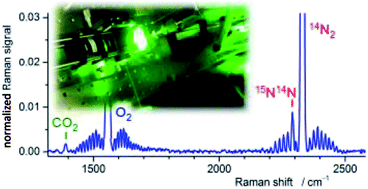Trace gas and dynamic process monitoring by Raman spectroscopy in metal-coated hollow glass fibres†
Abstract
Results on using capillary Raman spectroscopy as an approach for improving the speed, sensitivity and limit of detection for quantitative analysis of gases are reported. Specifically, its potential for trace component identification and rapid process control has been explored. Using a metal-lined hollow glass capillary configuration, its Raman signal was found to be two orders of magnitude larger than that from a conventional 90° Raman implementation. However, the actual improvement in the signal-to-noise ratio and thus the limit of detection was markedly lower, due to an increase in the fluorescence background generated in optical components in the laser beam path and the capillary body itself. Using careful, systematic suppression strategies, the signal-to-noise ratio of our capillary setup increased by a further factor of 3–4, now yielding detection limits for trace gases well below the 100 ppm level. In a “dynamic” measurement series the time evolution of catalytic gas mixing of H2 and D2, to form HD, has been recorded, in which sub-mbar detection limits in sub-second recording times were achieved.


 Please wait while we load your content...
Please wait while we load your content...